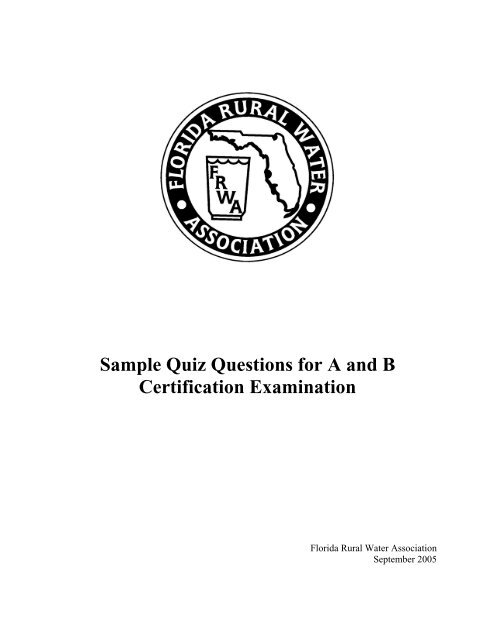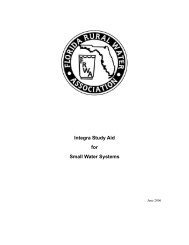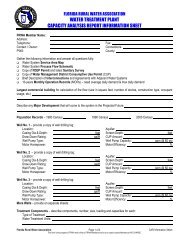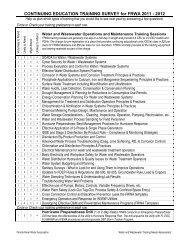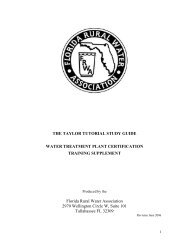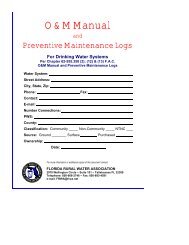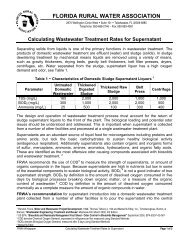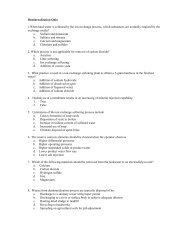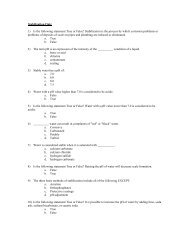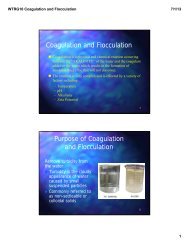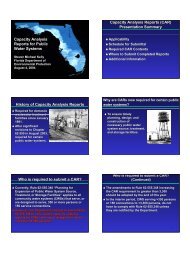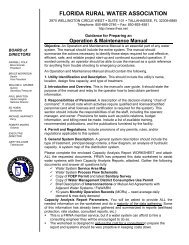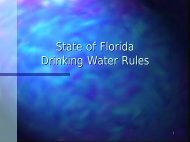A&B Test Questions - Florida Rural Water Association
A&B Test Questions - Florida Rural Water Association
A&B Test Questions - Florida Rural Water Association
Create successful ePaper yourself
Turn your PDF publications into a flip-book with our unique Google optimized e-Paper software.
Table of ContentsCHLORINATION AND DISINFECTION ................................................................................ 3DISINFECTION BY-PRODUCTS ........................................................................................... 10LIME SOFTENING ................................................................................................................... 12ION EXCHANGE SOFTENING .............................................................................................. 20REVERSE OSMOSIS ................................................................................................................ 23WATER STABILIZATION ...................................................................................................... 25IRON AND MANGANESE REMOVAL ................................................................................. 30TASTE AND ODOR REMOVAL ............................................................................................. 32FILTRATION ............................................................................................................................. 35SEDIMENTATION .................................................................................................................... 39COAGULATION AND FLOCCULATION ............................................................................. 41WATER CHEMISTRY .............................................................................................................. 462
Chlorination and Disinfection1. The limit of chlorine gas withdrawal for a ton cylinder in a 24 hour period is abouta. 85 % of the cylinder’s volumeb. 40 pounds/dayc. 8 pounds/day per degree fahrenheitd. 17 % volume/hr. per degree Celsius2. In the event of a chlorine leak, the effected area should be diked with what chemicals tocontain and neutralize the chlorinea. NaOH, CaO, Ca(OH)2, Na2CO3b. NaPO 4, NaCL, CaCO 3 , A1 2 (SO 4 ) 3c. KMnO 4 . NaCL, CaCO 3, A1 2 (SO 4 ) 3d. NaCLO 2 , Ca(P0 4 ) 2 , Ca(OH) 2 . Na 2 CO 33. Hypochlorite is being feed with a hypochlorinator at a set rate of 66gals/day and uses a 7 %available free chlorine solution. What is the dose at a rate of 2.4 MGD?a. 1.5 mg/Lb. 11.1 mg/Lc. 1.9 mg/Ld. 3.0 mg/LMath ApplicationsSection4: The disinfecting power of chlorine diminishes whenA: temperature decreases, OCL ion predominatesB: temperature increases, OCL ion predominatesC: temperature increases, HOCL acid predominatesD: temperature increases. OCL ion and HOCL acid are equal5 On a gas chlorinator, the Injector vacuum reading is low. Injector water supply is 70 PSI. WhatIs the probable cause ?A: Insufficient water pressure at the orificeB: CPRV (chlorine pressure regulating valve)C: injector orifice needs adjustmentD; flow restricted though the Injector orificeTROUBLESHOOTINGGUIDESection3
6: Chlorine dioxide reacts with water to form ______A: CL O 2 ions and Cl O3 ionsB: CL O 2 and NaCL O 2C: CL- ions and Na ionsD; H Cl ions and NH 2 Cl7: Identify the proper fiat of diseases that may be transmitted by water.A: encephalitis, amoebic dysentery, common cold, pneumoniaB: small pox, botulism. spotted fever, enterotoxigenicC: chicken pox, giardiasis. whopping cough, measlesD: giardiasis, typhoid fever, dysentery, hepatitis A8: The Pressure gauge from the chlorine cylinder reads 90 psi. The gauge on the chlorinator reads8 psi. The chlorine residual is dropping. What is the probable cause?A: faulty injector (no vacuum)B: restriction in supply systemC: chlorine cylinder is going emptyD: CPRV is dirty and pluggedTROUBLESHOOTINGGUIDE9. What is the corrective action to be taken in the previous question?A: change out orificeB: adjust injector orificeC: Clean CPRV with acidD: Increase water pressure to InjectorTROUBLESHOOTINGGUIDE10: The Chlorine/ammonia compound with the most effective bactericide power isA: dichbromethaneB: dlchlorlamineC: monochloramineD: trichloramine4
20. Pressure in the chlorine header reads 110 lbs. The gauge on the chlorinator reads 5 lbs.Chlorine residual is dropping. What Is the probable cause?A: Injector throat is plugged ( no vacuum)B: restriction in water supply systemC: pig tail on the chlorine cylinder is froze upD: CPRV is pluggedTROUBLESHOOTINGGUIDESection21: A liquid chlorine spill can be controlled with?A: Ca (OH) 2B: NaOHC: H 2 OD: H2 SO4TROUBLESHOOTINGGUIDESection22: A major Limitation of using chloramine residuals is the fact thatchloramines:A: are not effective as a disinfectant as free chlorineB: form trihalomethanesC: increases contact time requiredD: alter the pH of the water23: The pH of the water being disinfected can alter the efficiency of disinfectants. Chlorine forexample disinfects water (complete the sentence):A: much better at a pH of 8.0 than at a pH of 6.0B: much faster at a pH of 7.0 than at a pH over 8C: the same regardless of pHD: much faster at an alkaline pH than at an acidic pH24: In establishing a breakpoint curve for a particular water, when chlorine is first added ItImmediately oxidizes iron, manganese, and nitrite. As more chlorine is added, enough toreact with ________ and _________ chlororganics and chloramines are formed.A: hydrogen sulfide / sulfurB: trihalomethanes / VOC sC: chlorine dioxide / sodium chloriteD: organics / ammonia7
25: Which one of the following is true with regards to the use of chlorine as a disinfectant?A: chloride ions (Cl) increase the disinfection power of chlorineB: sodium hypochlorite will the lower the pH of the waterC: chloramines to form when the water contains hydrogen sulfideD: chlorine gas will lower the pH of the water26: The most effective in-plant destruction of bacteria with chlorine is best accomplished by:A: a low concentration ant short contact timeB: a low concentration and high pHC: a low temperature and a high pHD: a high concentration and long contact time27: The following reaction is influenced by the pH of the water being disinfected:HOCI = H+ + OCl- : The lower the pH, the greater the percentage of —— which will bepresent, thus yielding better disinfection action.A: H +B: OCl-C: HOClD: HCl28. When a chlorinator will feed OK at maximum output, but will not control at low rates, the mostprobable cause is:A: the vacuum regulator valve is closed or stuckB: the flow of water is too lowC: clogged throatD: plugged restrictor29: A purpose of adding ammonia to potable water is to:A: adjust pHB: form combined chlorine residualC: remove turbidityD: protect teeth30: Carbonate scale may be removed from a hypochlorinator by using:A: sulfuric acidB: nitric acidC: muriatic acidD: sodium hydroxide8
31. Seven pounds of HTH (65% chlorine ) are added to 90 gallons of water and used as a dosingsolution. At the end of the day, only 82 gallons of the solution were used. How manypounds of chlorine were actually fed?A: 6.4B: 8.9C: 4.2D: 10.5MATH APPLICATIONSection9
Disinfection By-Products1: Trihalomethane precursors can be defined as:A: naturally occurring inorganic compoundsB: naturally occurring metal cationsC: naturally occurring oxidizing compoundsD: naturally occurring organic compounds2: Samples for THM levels are collected and reported:A: weeklyB: monthlyC: quarterlyD: annually3: Trihalomethanes are formed by the combination of:A: free chlorine and Inorganic compoundsB: free chlorine and natural hydrocarbonsC: chlorine dioxide and natural tannic acidsD: all primary disinfectants and natural organics4: Which one of the following would lead to the least amount of trihalomethaneformation ?A: a high concentration of natural organicsB: a high water temperatureC: high pHD: low pH5. A minimum of how many samples per quarter for THM analysis must be takena. 2b. 4c. 6d. number of samples is based on population6. What treatment techniques removes THM precursors and bivalent ions?a. aerationb. ozone treatmentc. potassium permanganate additiond. lime softening10
7. You have a minor THM problem and decide to add ammonia to the filter effluent. You areconcerned about taste and odor problems. Therefore you should add ammonia at a ratio,which will produce which compounds?a. Monochlorominesb. Dichlorominesc. Dichlorominesd. Chlorophenolse. Haloacetic AcidsTROUBLESHOOTINGGUIDE11
Lime Softening1. Minimum hardness that lime soda ash softening can achieve isa. Zerob. 30 to 40 mg/lc. 80 mg/Id. 80 to 90 mg/i.2. The purpose of adding carbon dioxide to softened water ís to:a. reduce lime usagea. Increase finished water pHb. restore the methyl alkalinityd. restore the carbonate balance3. Lime sludge may be dewatered bya. pondsb. solar lagoonsb. solids contact unitsc. sludge collectors4: Non-carbonate hardness can only be reduced by which of the following processes?A: Ca(OH) 2 , ion exchange. RO. electrodialysis, NaOHB: lime soltening , coagulation, filtration, disinfectionC: Na 2 CO3, ion exchange, membrane separation, NaOHD: reverse osmosis, chlorine dioxide, CaO, oxidation5: Complete the following statement: Selective carbonate removal isA: removal of calcium bicarbonate hardness at pH of 9.6B: removal of magnesium bicarbonate hardness at pH 10.6C; removal of non-carbonate hardness at pH 10.0D: removal of calcium sulfate hardness at pH 10.612
6: Using the chemical analyses below, calculate the correct results.Total Hardness: 180 mg/LPhenolphthalein Alkalinity: 50 mg/LTotal Alkalinity: 90 mg/lA: HCO 3 : 10 mg/l, CaCO3: 100 mg/l, OH:0, NCH 90 mg/lB: HCO 3: 100 mg/l, CaCO3 10 mg/l, OH 0 mg/l, NCH 0 mg/lC: HCO 3 : 0 mg/l, CaCO3 80 mg/l, OH 10 mg/l, NCH 90 mg/lD: HCO 3: 10 mg/l, CaCO 3 0 mg/l, OH 80 mg/l, NCH 0 mg/lMATHAPPLICATION7: When is noncarbonate hardness is present in water?A: when the total hardness is greater than total alkalinityB: when the total hardness equals total alkalinityC: when the total alkalinity is greater than total hardnessD: when the total alkalinity is twice the total hardness8. Select the correct statement.A: Ion exchange softening will remove non carbonate hardnessB: Lime. Softening will increase the calcium content of the waterC: Lime Softening will reduce the hardness to near zeroD: Ion exchange softening will reduce the Na content of the treated H 2 09: Non-carbonate hardness can be removed by which of the following processes?A: Ca(OH) 2 , ion exchange, oxidation, ROB: lime softening. coagulation, filtration, disinfectionC: Na 2 CO 3 , NaOH precipitation, Ion exchangeD: reverse osmosis, chlorine dioxide, CaO, oxidation10: Complete the following statement: Selective carbonate, removal isA: removal of calcium bicarbonate hardness at pH 9.6B; removal of magnesium bicarbonate hardness at pH 10.6C: removal of non-carbonate hardness at pH 10.0D: removal of calcium sulfate hardness at pH 10.613
11. Using the analyses below, calculate the lime dose needed in mg/l as CaO.Atomic Weights: Ca:40, Mg: 24, H:1, C:12, O: 16, Na:23, F:19C02: 10 mg/l, Ca:2l8 mg/l, Mg:32 mg/l, TA: 180mg/l, Temp. 78 FA: 393 mg/lB: 250 mg/lC: 189 mg/lD: 222 mg/lMATH APPLICATIONSection12. Using the dosage from the previous question, calculate the lime demand.Lime 92% pure, flow 3.250 MGD, excess = 7%A: 6998 pounds of limeB: 5959 pounds of limeC: 811 pounds of limeD: 7881 pounds of limeMATH APPLICATIONSection13: Using the following data, calculate the Na 2 CO 3 demand.Raw <strong>Water</strong>: Ca: 265 mg/l. Mg: 32mg/l, T ALK:16Omg/l CO2: 12 mg/lFin. <strong>Water</strong>: Ca: 165 mg/l. Mg: 32 mg/I, T ALK: 130 mg/l. C02: 106 mg/lFlow 865,000 gallons, Na 2 CO3: 98 % pureA: 546 pounds of soda ashB: 5l5 pounds of soda ashC: 1069 pounds of soda ashD: 297 pounds of soda ashMATH APPLICATIONSection14: When is MgCO 3 hardness present in water?A: when the total hardness is greater than total alkalinityB: when the total hardness equals total alkalinityC: when the total alkalinity is greater than total hardnessD: when the total alkalinity is twice the total hardness15: Which of the following constituents cause non-carbonate hardness?A: CaSO 4 , CaCO 3 . MgCL2, NaOH & Sr(HCO 3 ) 2B: CaSO 4 . CaCO3, MgCL 2 . NaOH & MnSiO 3C: MgSO 4 , MgCO 3 , NaCL. 2 , Ca(OH) 2 , Fe(HCO3)2D: CaSO 4 , CaCL 2 , MgCL 2 , MgSO 4 , & SrSO 414
16: Selective Carbonate hardness removal requires the use of:A: soda ashB: carbon dioxideC: limeD: lime and soda ash17. The softening process samples indicate the following data:T Alkalinity: 90 mg/l. P Alkalinity 40 mg/l.Treatment parameters call for a treatment range of +2 to +5 hydroxide alkalinity. From theanalysis what action should you take?A: decrease Lime feedB: increase carbon dioxide feedC: decrease carbon dioxide feedD: increase lime feed18: You are operating a lime softening plant where magnesium removal is necessary. The processincludes lime addition, recarbonation and filtration. How could you maintain the quality oftreatment and also save on operating costs?A: eliminate recarbonation and use split treatment to lower the pH and save on limeB: add calcium carbonate to saturate the softened waterC: feed lea lime and more soda ashD: recarbonate after filtration19: You are operating a lime softening plant which produces a finished water with a total hardnessof 80 mg/l as Ca CO3, and a Langelier Index of +0.6.What is the problem?A: the finished <strong>Water</strong> is aggressiveB: too much CO2 was addedC: the finished water hardness is too lowD: the finished water will be scale forming20: What caused the problem in the question above?A: the pH was too lowB the excessive CO 2 increased the L. I.C: too much blendingD: excessive calcium carbonate15
21: In spilt treatment, a portion of the water, about ____ is treatedwith an excess amount of lime to remove the ____ pH of over ____.A: 20%; calcium; 7B: 90%; calcium; 8.3C: 20%; magnesium; 7D: 90%; magnesium; 11.122: The determination of total hydroxide alkalinity is an important control test used in the limesoftening process. What is the correct method of determining this number?A: T.H.-T. Alk.B: 2T - PC: 2 P - T.H.D: 2 P – T23. Soda ash is commonly used in water treatment to:A: remove temporary hardnessB: remove all hardnessC: remove permanent hardnessD: lower the pH24: Calculate the dosage in mg/l hydrated lime Ca(OH)2 required tosoften the water with the characteristics given. /ParameterCO2 12 mg/ l 0 mg/lTotal Alkalinity 202 mg/l 30 mg/lTotal Hardness 230 mg/l 50 mg/lMg 10 mg/l 2 mg/lPH 7.2 9.0Lime Purity 90%A: 188 mg/LB: 256 mg/LC: 287 mg/LD: 174 mg/LMATH APPLICATIONSection16
25. Calculate the amount of soda ash Na 2 CO 3 required to remove the noncarbonate hardness in theabove problemA: 30 mg/lB: 45 mg/lC: 60 mg/lD: 125 mg/lMATH APPLICATIONSection26: in spit treatment excess lime is added to a portion of the water to remove:A: calciumB: IronC: magnesiumD: manganese.27. What chemical is used to remove non-carbonate hardness in chemicalprecipitation softening?A. carbon dioxideB: calcium sulfateC: sodium carbonateD: calcium hydroxide28. Split treatment can eliminate the need for:A: lime softeningB: recarbonationC: soda ashD: filtration29. You are using pH to determine lime addition in a lime softening plant. The pH meter indicatesa pH of 10 but after you have added lime you determine that the dose was excessive. What isthe most probable cause?a. The water contained an excessive amount of pHb. PH was actually 9c. The water contained excessive alkalinityd. The meter read 10 when it was actually much highere. The lime slaker has malfunctionedTROUBLESHOOTINGGUIDE17
30. What will the dosage rate be for a softening plant using 7O% hydrated lime to apply a limedosage of 45 mg/l to a flow of 3.2 MGD.a. 1816 lbs./db. 1716 lbs./dc. 1616 lbs./dd. 1516 lbs./dMATH APPLICATIONSection31. The following are alkalinity titration results and expected conditions:P = Phenolphthalein AlkalinityT = Total AlkalinityO = Not PresentMATH APPLICATIONSectionTitration Result Bicarbonate Carbonate HydroxideP=0 T 0P < ½ T T – 2P 0P = ½ T 0 0P > ½ T 0 2P –TP = T 0 TWhich is the correct set of data for the Carbonate Conditions?a. O, P, 2P, 2T –2P. Ob. O, 2P, 2P, 2T –2P, Oc. O, 2P, P, 2T –2P, Od. O, 2P, 2P, T –P, Oe. O, 2P, 2P, 2T –2P, O .32. When alkalinity (as CaCO3) is greater than the total hardness and the pH is 9.0 you must ____to soften the water.a. Raise the pH to 9.3b. Reduce only the Carbonatesc. Increase the P alkalinityd. Precipitate noncarbonate (permanent) hardnesse. Precipitate Hydroxides18
33. You have added excess lime to your raw to ensure complete softening reactions, Now you havescaling problems in the water distribution system and need to convert the carbonate ions intosoluble forms. It would be best for you to:a. Use Hydrochloric Acid to precipitate calcium carbonateb. Assure that the following reaction occurs: Mg(HCO3)2 + 2 NaOH >Mg(OH)2 + 2 Na2CO3 + 2 H2Oc. Lower the pH using recarbonationd. Add additional lime to increase precipitant in clarifier and force the reactions tocompletione. Add Soda Ash to decrease non-carbonate scale34. You have increasingly corrosive water in a lime softening plant. The calcium hardness timesthe alkalinity has been near 100 for some time. Now the product is 95. What additionalchemical may be required?a. Caustic Soda (Na OH)b. Carbon Dioxidec. Soda Ashd. Potassium Permanganatee. Hexametaphosphate35. The first step in the softening process isa The conversion of carbon dioxide to calcium carbonateb. The conversion of magnesium bicarbonate to calcium carbonate.c. The conversion of magnesium carbonate to calcium carbonate.d. The conversion of calcium bicarbonate to calcium carbonate36. The minerals that cause hardness in water are precipitated out of the water asa. calcium carbonateb. magnesium carbonatec. calcium carbonate and magnesium carbonated. calcium carbonate and magnesium hydroxide19
Ion Exchange Softening1. Minimum hardness that Ion exchange softening can achieve isa. zero hardnessb. 30 to 40 mg/lc. 80 mg/I.d. 80 to 90 mg/l2. When hard water is softened by ion-exchange, which substance is exchanged for calciumand magnesium and will appear in the product watera. calcium carbonatea. sulfatesb. chloridec. sodium3. Which of the following. is not affected by passing through a ion-exchange unit.a. sodiumb. manganese ( when present at less than 0.2 mg/l)c. magnesiumd. pHThe following 6 questions are based on the data given below:Ion exchange softeners: 4 each @ 28.5 ft diameter x 7 ft. media depthExchange capacity: 25 kilograms / cubic footSalt requirements: 0.4 lbs/kgr.MATHBrine specific gravity:Flow:1.258, 640,000 gallons per dayRaw hardness: 513 mg/LFinish hardness: 85 mg/LAPPLICATION4: How many GPM are being softened assuming the daily flow is continuous for 24 hours ?A: 5006 GPMB: 994 GPMC: 6000 GPMD 36,000 GPMMATH APPLICATIONSection20
5: How many kilograms can be removed by all of the softeners ?A: 111, 583 kgrB: 223, 164 kgrC: 446, 331 kgrD: 62. 643 kgrMATH APPLICATIONSection6: If all the ion exchange units were started at the same time and operated until their exchangewas exhausted, how many gallons would have been softened to near zero hardness?A: 3,719, 433 galsB: 2,088,100 galsC: 7, 438. 800 galsD: 14, 877, 666 galsMATH APPLICATIONSection7. In the question above, how many hours and minutes would have elapsed?A: 49 hrs. and 32 minB: 41 hrs. and 19 min.C: 12 hrs. and 23 mm.D: 24 hrs. and 46 min.MATH APPLICATIONSection8: How many pounds of salt are required to regenerate each softener ?A: 78, 532 lbsB : 44, 633 lbsC: 25, 057 lbsD: 278, 958 lbsMATH APPLICATIONSection9: How many gallons of saturated brine are required for each regeneration?A: 21, 407B: 85, 629C: 11, 989D: 133. 473MATH APPLICATIONSection10. If the finished water from an ion exchange unit has a salty taste, a probable cause for theproblem may be:A: too much lime was fedB: the rinse stage was unsuccessfulC: too much zeolite was applied to the mediaD: too much chlorine was present11. The primary cause of resin breakdown in ion exchange softening is:A: oxidation by permanganateB: excessive backwashingC: iron foulingD: the presence of high chlorine residuals21
12. The third stage in the ion exchange process isa. serviceb. backwashc. brined. rinse13. In Ion exchange softening, if Iron in the ferric form is found in the waterwhat will occur in the softening unit?A: the resin will remove the IronB: the unit act as a filterC: nothing will changeD: the unit will automatically shutdown14. In Ion exchange softening a high chlorine residual will:A: have no effectB: regenerate the resinC: damage the resinD: short circuit the unit22
Reverse Osmosis1. The cause of lower than normal product water flow rates and higher than normal saltrejection in an R0 plant isa. membrane hydrolysisb. membrane foulingc. membrane compactiond. membrane failureTROUBLESHOOTINGGUIDE2. The solution to the problem in question 117 isa. replace elementb. clean elementc. colloidal injectiond. all of the aboveTROUBLESHOOTINGGUIDE SECTION3. Reverse Osmosis increasing the flux ratea. will cause an increase in salt concentrationb. will not affect the salt concentrationc. will reduce the salt concentrationd. will cause salt build up and polarization4. Constituents affecting the RO include all but which of the following:a. pHb. Temperaturec. Suspended Solidsd. Microbrial Concentratione. Conductivity5. Fouling in RO systems is typically caused by:a. Backwash Frequencyb Service on Membranesc. High <strong>Water</strong> Pressured. Bacteriae. Concentration of Calcium in Rinse <strong>Water</strong>23
6. Polarization in an RO system is caused by:a. Fouling caused by high hardnessb Fouling of the Anode or Cathodec. Brine or Regeneration concentration that is too highd. Mineral Deposits along the edge of a membranee. Plugging of Membrane inner surfaces7. Reverse Osmosis Systemsa. do not require pretreatment to remove colloidal material.b. are designed to remove minerals and colloidal materialc. require pretreatment to remove colloidal materiald. can remove colloidal material only if coagulants are added to reject8. RO systems are best operated with all units1. in series to gain maximum removal rates2. in parallel to gain maximum throughput3. staggered with gradually decreasing number of modules4. staggered with gradually increasing number of modules9. The reserve osmosis elements should be cleaned when the operator observesa. Higher differential pressuresb. Higher operating pressuresc. Higher suspended solids in product waterd. Lower product water flow ratee. Lower salt rejection10. If a salty taste is noted in an RO process what is the most probable cause:a. Polarization is occurringb Service rate us too lowc. Brine or Regeneration Rate should be increasedd. Recycle Stream is too highe. Rinse Rate should be increased24
<strong>Water</strong> Stabilization1. Removal of hydrogen sulfide from water with a pH of 9.4 can be accomplished bya. increasing coagulant chemicalsb. lowering the PHc. increasing aeration and lowering pHd. increasing aeration2. Corrosion resulting from contact between two dissimilar metals is calleda. tuberculation corrosionb. erosion corrosionc. pitting corrosiond. galvanic corrosion3. Corrosion that forms mounds of iron oxide next to the anode is calledd. tuberculation corrosione. erosion corrosionc. pitting corrosiond. galvanic corrosion4. Chlorides tend to increase which type of corrosiona. tuberculation corrosionb. erosion corrosionc. pitting corrosiond. galvanic corrosion5. Turbulence tends to increase which type of corrosiona. tuberculation corrosionb. erosion corrosionc. pitting corrosiond. galvanic corrosion6. Black water complaints may be caused bya. corrosion of copper linesb. corrosion of ductile iron pipesc. sulfide corrosion of iron linesd. microbial activityTROUBLESHOOTINGGUIDE(SEE TABLE)25
7. The primary source of household plumbing problems isa. tuberculation corrosionb. erosion corrosionc. pitting corrosiond. galvanic corrosionTROUBLESHOOTINGGUIDE SECTION8. If a pH of a finished water is 8.0 and has high levels of carbon dioxide and dissolvedoxygen, the water isa. noncorrosiveb. corrosivec. scale formingd. saturated9: In order for Ca CO3 film to form, one of the following conditions must bemet.A: no HCO 3 ions must be presentB: pH values must be In excess of 10C: the water must be undersaturated with OH IonsD The. Langlier Index must be zero10: Identify the correct reaction that will form a calcium carbonate film.A: Ca 2+ + HCO3 + OH > CaCO 3 + H 2 0B: Ca 2+ + CaCO 3 + OH> HCO3 + H 2 OC: CaCO 3 + CO3 + H2O > Ca 2 + 2 HCO3D: 2 HC0 3 + CO3 + H 2 0 > Ca 2 + CaC0311. Which one of the following is not one of the indices that can be used to determine calciumcarbonate saturation of a water?A: driving force indexB; Langelier indexC; Rossum indexD: aggressive indexTROUBLESHOOTINGGUIDE SECTION26
12: From the results of the MARBLE TESTS below, which sample would be corrosive to awater system over a long period of time?Sample pH Alk. Hardness1 before CaCO3 8.3 84 1171 after CaCO3 8.3 84 1172 before CsCO3 8.3 90 1182 After CaCO3 8.1 88 115TROUBLESHOOTINGGUIDE SECTION3 before CaCO3 7.8 88 140After CaCO3 8.2 94 1484 before CaCO3 7.9 90 1384 after CaCO3 8.0 89 133A: sample 1B: sample 2C: sample 3D sample 413: positive Langlier Index is an indicator that the water isA: corrosiveB: scale formingC: stableD: equilibriumTROUBLESHOOTINGGUIDE SECTION14: The metabolic process that consumes oxygen and releases carbon dioxide is called?A: respirationB: photosynthesisC: eutrophicationD sterilizationE. hydrolosis15: Low pH and the absence of oxygen in a section of the distribution system may result inA: the formation of phenol-misted odorsB: The de-zincification of ductile pipeC: formation of hydrogen sulfideD: conditions ideal for the growth of aerobic bacteria27
16. A Langlier Index 0 or a Driving Force Index of 1 indicates the water isA; supersaturatedB: saturatedC: undersaturatedD: corrosiveTROUBLESHOOTINGGUIDE SECTION17. The parameters necessary to calculate the Driving Force Index are?A: temperature, CaCO3, pH, Oxygen, K’ sp for CaCO3B: temperature, pH, Mg, Free CO2, total alkalinityC: temperature, pH, Salinity, Hardness, CO3 2- , mg/l as CaCO3D: temperature, TDS, Ca hardness, CO3 2- , mg/l as CaCO3, K’ sp for CaCO318. Electrolysis is the result of ______.A; a corrosive oxygen cellB: a corrosive galvanic cellC: breakdown of Cathodic protectionD: stray electric current19: From the following water analysis, which corrosion control chemicals would be best toselect?Ca 2+ hardness: 40 mg/L Total Alkalinity: 11 mg/L TDS: 137A line or sodium carbonateB: lime or caustic sodaC: lime and carbon dioxideD: caustic soda or soda ash20: When a galvanic cell occurs as a result of two dissimilar metals. It is important to know thatcorrosion will always occur at the:A: neutral electrodeB: cathodeC: potentiometric surfaceD: anode21: _______ Inhibits corrosion by forming a film on the interior of water pipes.A: turberculesB: DOC: calcium carbonateD salinity28
22: Scaling is a problem in hot water systems because _____ is lesssoluble in hot water than In cold water.A: IronB: dissolved oxygenC: chlorineD: calcium carbonate23: <strong>Test</strong> results indicate a pHs value of 8.7 and a pH value of 8.8 for treated water. What doesthis mean?A: the water is corrosiveB: the Langleir index is between -0.2 and .0.2C: the pH should be increased to 9.5D: the water is undersaturated with calcium24: In selecting corrosion control chemicals, If the product from multiplying the calciumhardness by the alkalinity is 80, this indicates that:A: either lime or soda ash would be satisfactoryB: both lime and carbon dioxide may be requiredC: soda ash will be ruled out because of expenseD: the water is stable and requires no calcium25. gram of calcium carbonate is added to a filtered water sample giving the following results;determine the calcium carbonate precipitation potential.Initial pH = 8.7Final pH = 9.1Initial Hardness = 34 mg/lFinal Hardness = 38 mg/lInitial Alkalinity = 24 mg/lFinal Alkalinity = 27 mg/l.a. 0.4b. –3c. –4d. 3e. 429
Iron and Manganese Removal1. The mineral other than iron, that may occur in low concentrations and causes stainingproblems on laundry isa. ferricb. magnesiumc. rustd. manganese2. The most effective PH range for iron removala. 6 or lessb. 7 to 8c. 8 to 9d. 9 or higher3. In the greensand process, what chemical is necessary for the process to beeffective?A: chlorineB: limeC: potassium permanganateD: sodium carbonate4: When using aeration, the rate of oxidation of Iron to form Insoluble ferric can be increased by:A: decreassing the temperatureB: raising the pH of the waterC: decreasing the detention timeD: lowering the pH of the water5: Chemical doses being added to control Iron and /or manganese are inadequate if:A: analysis of treated water shows the presence of IronB: there is incomplete conversion of ferric iron to ionic ironC: customers complain of rusty waterD: all of the above30
6: Which one of the following is not a chemical oxidant which could be used to control taste andodor in water supplies?A: chlorineB: chlorine dioxideC: ozoneD: sulfur31
Taste and Odor Removal1. The first warning the supplier has of possible contaminants from across connection are complaints of taste and odors of:A: septic or mustyB: chemical, gasoline, or pesticideC rotten egg or sulfurD; fishy or swampy2: Aeration normally does not provide enough oxidant to attack:A: the taste and odor producing organicsB: organic compounds which are relatively volatileC: reduce forms of ferrous Iron and manganous manganeseD: The reduced inorganic compounds3: Powdered activated carbon slurry tanks are normally loaded at a rate of:A: one pound per gallon of <strong>Water</strong>B: one pound per pound of waterC: one pound per 100 pounds of waterD: one pound per million pounds of water4: Which of the following dosages is considered to be a typical or average load rate forcontrol of TOC with potassium permanganate?A: 0.10 to 0.50 mg/lB: 1.0 to 3.0 mg/lC 0.30 to 0.50 mg/lD: 1.3 to 1.7 mg/l5: You have a taste and odor problem which requires you to superchlorinate the water goingthrough your p1ant. How would you dechlorinate this water prior to distributing it?A. use calcium carbonateB. use hydrogen sulfideC: GAC or PACD: use thiosulfate32
6. What treatment process would best treat a water containing 250 mg/l of hardness, 100 CU’s ofcolor and a turbidity of 2 NTU’s.a. Conventional lime softeningb. Ion exchangec. ROd. Chlorination and filtration onlyTROUBLESHOOTINGGUIDE SECTION7. Which treatment process would best treat a water containing 80 mg/l of hardness, 1.0 CU’s ofcolor and a turbidity of .2 NTU’s.a. Conventional lime softeningb. Ion exchangec. ROd. Chlorination and filtration onlyTROUBLESHOOTINGGUIDE SECTION8. Which treatment process would best treat a water containing 350 mg/l of hardness, 10CU’s of color, 30 mg/I of total organic carbon and a turbidity of 2 NTU’s.a. Conventional lime softeningb. Ion exchangec. ROd. Chlorination and filtration onlyTROUBLESHOOTINGGUIDE SECTION9. Which treatment process would best treat a water containing 250 mg/l of hardness, 10 CU’s ofcolor and a turbidity of 2 NTU’s. The plant’s only customer requires a finished watercontaining zero hardness.a. Conventional lime softeningb. Ion exchangec. ROd. Chlorination and filtration onlyTROUBLESHOOTINGGUIDE SECTION10. Which treatment process would best treat a water containing 350 mg/l of hardness, 10CU’s of color, 3 mg/l of total organic carbon and a turbidity of 2 NTU ‘s.a. Conventional lime softeningb. Ion exchangec. ROd. Chlorination and filtration onlyTROUBLESHOOTINGGUIDE SECTION33
Problem: Marshy, or woody odor. Use this to answer questions 11. 12, and 13.11. Possible causeTROUBLESHOOTINGGUIDE SECTIONa. increase in organisms in water supplyb. increase in Actinomycetes in water supplyc. bacteria and/or algae increase12. Required checka. check for nitratesb. check for coliformc. check for organismsd. check for algaeTROUBLESHOOTINGGUIDE SECTION13. Possible solutiona. increase chlorinationb. add activated carbonc. apply algaecided. apply potassium permanganateTROUBLESHOOTINGGUIDE SECTION34
Filtration1. Persistent filter blinding may be overcome bya. changing mediab. changing or adjusting coagulantc. improving backwashd. using filter aidsTROUBLESHOOTINGGUIDE SECTION2. Mud ball formation in a filter bed may be caused bya. low surface scour ratesb. improper coagulationc. sludge removal ratesd. rapid mix speedTROUBLESHOOTINGGUIDE SECTION3. Greensand is regenerated withb. more greensandc. ion resind. potassium permanganatee. sand4. As a plant supervisor, two of our most important concerns are:a. Chemical and pathogen free drinking waterb. Clean and inexpensive drinking waterc. To provide consumers with drinking water of suitable quality and sufficientquantityd. Employee harmony and efficiencye. Safe working conditions and pure water.5. If you had to choose a single, easily run test which would give the best indicationOf water quality, you would choose which test?a. Hydrogen sulfideb. Turbidityc. THMd. TDSe. Color35
6. What should you do if test results indicate a filter mud ball volume of 2.6%a. Nothing, this is goodb. Add a polymerc. Reduce the coagulant dosed. “Bump” the filter gravele. Extend the backwash duration.TROUBLESHOOTINGGUIDE SECTION7. The design head loss in your filter is 10 feet. Your loss of head is 8 feet, the turbidity is 0.4NTUs and the elapsed run time is 24 hours. It would be best to:a. “Bump” the filter to delay backwashingb. Slow the flow to the filterc. Backwash the filter first thing next morningd. Increase the polymer doseTROUBLESHOOTINGGUIDE SECTION8. When a filter wash is uneven, the spots violently over washed might result in which of the following?a. Damage to sludge removal equipmenta. Cause the sand grains in this area to cement together.b. Cause an increase in the sand effective size.c. Overturn the gravel layer, allowing sand to displace it.9. When cold water starts to warm up, a condition that can occur in the media of a filter is calleda. Mudballingb. Jet actionc. Bed shrinkingd. Air bindingTROUBLESHOOTINGGUIDE SECTIONTROUBLESHOOTINGGUIDE SECTION10. Air binding of a filter can be caused bya. The reduction of pressure resulting from operating under a negative heada. An increase in the temperature of the water during filtrationb. The release of oxygen by algae collected within the filterc. All of the aboveTROUBLESHOOTINGGUIDE SECTION11. Some idea of the amount of filter media growth can be indicated bya. Periodic sieve analysis of the mediab. Periodic measurements of the distance from the top of the clean filter to the trough weirc. Periodic determinations of the percent solubility of the media in hydrochloric acidd. All of the aboveTROUBLESHOOTINGGUIDE SECTION36
12. Three items are missing in the information provided, Which one of the sets of data beloware the correct entries for the missing information for both filters?Filter Operating RecordNo,TimeStartStopHours OperatedToday Previous TotalHead LossStart StopWashMin M. Gal6/15 6/18 11:30 63.7 75.0 0.50 6.00 6 0.141 8:30 11:302 6/12 6/18 18:00 82.0 100.0 0.50 5.50 5 0.14Average Run Hours = _________Total Wash <strong>Water</strong> (MG) = _________Ave. Time of Wash = _________e. 87.5 hrs; 0.28 MG and 5.5 min.f. 72.65 hrs, 0.28 MG and 6 min.g. 72.65 hrs, 0.28 MG and 5.5 min.h. 75 hrs, 0.14 MG and 5 mini. 100 hrs, 0.14 MG and 5.5 min13. Mixed media filtersa. Use anthracite coal over sandb. May require a secondary coagulant applied ahead of the filters.c. Sometimes uses pressure to achieve higher filtration rates.d. All of the above37
14. All but one of the choices below are disadvantages of Aeration. Which is the mostimportant advantage?Aeration can:a. Lead to bacterial contaminationb. Remove THMs after they have been formedc. Remove volatile organic compoundsd. Perform as a reducing agente. Perform best a low pH.15. Your plant has a source water of consistent quality and the plant has a good performancerecord. Lately the filter turbidity removal efficiency has decreased. What is the most urgentcheck to perform?a. Raw water qualityb. Condition of flocculation basinc. Coagulant dosaged. Color content of water38
Sedimentation1. Sedimentation is improved bya. reducing detention timeb. short circuitingc. installing tube settlersd. all of the above2. A lime sludge collection device shoulda. move very slowlyb. move rapidly to collect as much sludge as possiblec. be turned on at regular intervals for a short timed. be turned on only when enough sludge is available to warrant use3. Preventive maintenance on an upflow clarifier includesa. leveling a weir to correct short circuitsb. rebuilding the drive unit motorc. replacing scraper bladesd. cleaning walkways4. You operate a surface water plant that uses an up-flow clarifier, has a raw water pH of 7.4 andan alkalinity of 260 mg/l. Each spring as the weather changes, you have a severe taste and odorproblem. What change might you consider for the clarifier to minimize this problem?a. Add additional coagulant and polymerb. Increase the amount of activated carbon in the slurryc. Change the through-put rate to the Clarifierd. Increase the sludge blanket depthe. Increase the amount of prechlorinationTROUBLESHOOTINGGUIDE SECTION5. In and up-flow clarifier, when you want to increase the depth of the slurry, without increasingits volume or density, what would you do?a. Increase the rising rateb. Raise the weirsc. Slowly decrease the flow rate to the Clarifierd. Rapidly increase the flow rate to the Clarifiere. Rapidly increase the overflow rateTROUBLESHOOTINGGUIDE SECTION39
6. It is in the middle of the summer and you are having a breakdown in the coagulationprocess in our up-flow clarifier due to algae, this problem occurs only in the late afternoon,with periods of good operation before and after this problem period. What changes shouldyou make during the problem periods to improve the finished water quality?a. Allow the Sludge blanket to buildb. Increase the amount of activated carbon in the slurryc. Increase the slurry leveld. Increase the sludge blanket depthe. Reduce the sludge blanket depthTROUBLESHOOTINGGUIDE SECTION40
Coagulation and Flocculation1. Pin point floc is a condition associated witha. flash mixingb. detention timec. poor filtrationd. low turbidity2. Operators are concerned primarily with particles in water that usually carry aa. negative electrical chargeb. positive electrical chargec. both positive and electrical charged. charge depends on location of plant3. The main purpose of flocculation is toa. allow chemicals to mix thoroughlyb. produce flocc. bring together micro flocd. improve settling4. An inspection of your Coagulation/Flocculation filtration plant yielded the followingproblems. Match the corrective action for each condition cited.Observed Conditions (match with number below)Corrective Actions1. Floc as it enters the basin is large and sheared2. <strong>Water</strong> has a milky appearance with a bluish tint3. Floc size increases in the flocculation basin then starts to break up.4. Floc rapidly settles in the first part of the sedimentation basin.a. Mixing intensity of the downstream flocculator is too highb. Excessive Coagulant dosagec. Excessive alum dosaged. Flash mixer is set too higha. d,b,a,cb. a.c.d.bc. c.d.a.bd. d,c,a,bTROUBLESHOOTINGGUIDE SECTION41
5. Your feed rate scale for Flocculation chemicals is in pre-set (with a range of 100%) and isset at a maximum feed rate of 15%. You have determined that the best feed rate for theFlocculator is 3 GPH. What should the feeder be set on?a. 5%b. 12%c. 20%d. 30%e. 45%MATH APPLICATIONSECTION6. You suspect a problem with your chemical feeder. From the following data, determine theproper chemical feed rate.Starting Level of container pumped fromLevel of chemical after pumpingFeed Time= 1000 ml= 800 ml= 30 sec.a. 1.25 ml/minb. 26.7 ml/minc. 200 ml/mind. 260.7 ml/mine. 1600 ml/minMATH APPLICATIONSECTION7. The inorganic compounds (i.e. iron) are effectively removed from your raw water usingaeration. <strong>Test</strong>s indicate an increasing taste and odor problem due to volatile organiccompounds. Which action below would be best for these circumstances?a. Reduce the aeration rateb. Increase detention period to allow more organics to burn offc. Increase blower pressured. Add a reducing agente. Add an oxidizing agent42
8. A random listing of procedures used to start up a coagulation flocculation process is listedbelow. Place the procedure in the proper order.1. Start chemical feed system2. Run a jar test on the raw water3. Turn flash mixer on4. Start sampling pumps5. Open raw water inlet gate6. Check condition of all mechanical equipment7. Begin disinfection8. Observe floc formationa. 5, 2, 1, 7, 3, 4, 8, 6b. 6, 2, 5, 1, 7, 3, 4, 8c. 5, 6, 2, 1, 7, 3, 4, 8d. 6, 5, 1, 2, 7, 3, 4, 8e. 6, 2, 5, 1, 4, 7, 3, 89. You have adverse changes in the raw water temperature. It would be best to adjust the flashmixer but this is not possible in your plant. Which action below would be the mostappropriate?a. Reduce the amount of coagulant chemicalb. Increase the amount of coagulant chemicalc. Increase the pH with soda ashd. Add an ionic filter aid chemical polymere. Adjust the mixing intensity of the flocculatorTROUBLESHOOTINGGUIDE SECTION10. You have observed that the floc as it enters the flocculation basin is not well dispersedthroughout the flow. What is the most likely problem?a. No problem, it will ix as it gets to the sedimentation basinb. Flash mixer too slowc. Coagulant dose too highTROUBLESHOOTINGd. Feed rate too highGUIDE SECTIONe. Polymer addition needs to be increased43
11. You are considering the addition of alum to your up-flow clarifier. You determine that 12mg/l of alum is correct. The raw pH is 8.0 and the alkalinity is 230 mg/l. You know that ittakes an excess of 21 mg/l of alkalinity per mg/l of alum for precipitation to occur. Whatwould be the best selection in this situation?a. Go ahead and slowly start adding the Alumb. Add additional alum to increase the alkalinityc. Add lime or soda ash to increase the alkalinityd. Add carbon dioxide to decrease the alkalinitye. Adjust the mixing intensity of the flocculator12. You use alum as a coagulant. Here would it be best to take a sample of the water for a jartest in order to set a target pH?a. Between the flocculation and the sedimentation basinb. Before chlorination of the finished waterc. Just past the raw water inlet gated. After the flash mixere. In the mixing zone of the sediment basin13. You raw water alkalinity increased from 230 mg/l to 235 mg/l and the pH to 7.9. Yourchlorine residual then dropped below acceptable limits. What is the most likely cause ofthis condition?a. Excess alkalinity reacted with the chlorineb. Chlorine has been converted to hypochlorous acidc. Chlorine has reacted with mineral compounds that raised the pHd. There has been an increase in hypochlorite14. Alum usuallyTROUBLESHOOTINGa. has an optimum PH of 5.5 to 6.8GUIDE SECTIONb. is effective on highly colored waters at pH’s below 5.5c. effective with high mineral waters at PH as high as 7.5d. all of the above15. Sodium Aluminate TROUBLESHOOTINGGUIDE SECTIONa. acidicb. very corrosivec. reduces both carbonate and noncarbonate hardnessd. all of the aboveTROUBLESHOOTINGGUIDE SECTION44
16. Proper coagulation results ina. reduction in turbidityb. pH adjustmentc. increase in filter runsd. all of the above17. The optimum pH range for ferric sulfate usage isa. 3.5 to 5.5 and above 9b. below 4.2 and above 8.2c. above 8.3d. above 9.618. Sodium Aluminate isa. Alkalineb. Acidicc. not expensivee. has a pH of 7TROUBLESHOOTINGGUIDE SECTION19. The influent into the plant has a high color and a turbidity of .05 NTU. What can be done toimprove coagulation.a. add alumb. add limec. add Bentonite clayd. A or B and CTROUBLESHOOTINGGUIDE SECTION20. Polymers are:a. coagulantsb. coagulant aidsc. used for removing colord. corrosive inhibitors45
<strong>Water</strong> Chemistry1. Which of the following is not a correct statement for the specific conductance test?a. Specific conductance is measured in microhmos per centimeterb. Specific conductance is the water’s ability to conduct currentc. Organic matter such as sucrose will increase the specific conductanced. Specific conductance can be used to estimate dissolved solids concentrations in thewatere. Specific conductance is affected by temperature2. pH is a measure of thea . amount of acidb. strength of an acidc. acidityd. alkalinity3. Noncarbonate hardness is caused bya. alkalinityc. calciumc. bicarbonate ionsd. sulfates4. Carbonate hardness is caused bya. carbonate and bicarbonate ionsb. carbonate ionsc. bicarbonate ionsd. sulfates5. Alkalinity can also be calleda. carbonate hardnessb. noncarbonate hardnessc. phenolophthalein alkalinityd. methyl alkalinity6. Alkalinity is expressed asa. mg/l phenolophthalein alkalinityb. mg/l of methyl alkalinityc. mg/l of calcium carbonated. total alkalinity46
7. A shorthand name for a chemical element isa. chemical compoundb. chemical formulac. scientific notationd. chemical symbol8. Organisms that can make their own food from strictly inorganic matter are calleda. autotrophicb. parasiticc. heterotrophicd. aerobic9. Oxygen bound up in such compounds as sulfates and nitrates may serve as Oxygen sourcesfora. aerobic organismsd. plantsc. algaed. facultative organism.10. When shutting down a fluoride system operators shoulda. confirm that safety guards are in placeb. examine all fittings and drains for leaksc. flush out solution linesd. inspect all equipment for binding and rubbing11. Free chlorine residual refers toa. dichloramirieb. hypochlorinationc. trichloramined. total chlorine12. Which chemical is used to oxidize iron and manganesea. alumb. monochloraminec. calcium oxided. potassium permanganate47
13. Health authorities encourage use of reclaimed water fora. drinking water supplyb. municipal swimming poolsc. deep well injectiond. landscape impoundment’s14. Which of the following affect the efficiency of copper sulfatea. dissolved oxygenb. organic carbonc. irond. temperature15. Possible Checksa. check for toxic conditionsb. check for dissolved oxygenc. check for algaed. check or organics16. Possible solutiona. ensure adequate chlorinationb. increase calcium oxide dosec. apply ferric chlorided. apply copper sulfate17. You are conducting a pH test with a meter which does not have a slope knob. You must usethe temperature knob to reach pH 10. Which action should you take?a. Add more pH to buffer solutionb. Allow more time for the CO2 to doissapatec. Replace the electrodesd. Allow more time for the temperature to stabilizee. Change the buffer solution to a pH 10 to 11.48
18. Flow recordersa. record the rate of flow at a given timeb. record the total flow through the plantc. function similar to an odometerd. record raw water flow19. Samples taken for PH measurement should bea. refrigeratedb. tested within one hourc. allowed to warm to room temperatured. measured for temperature20. Advantages of using a dissolved oxygen probe and meter include.a. less chance of errorb. probe and meter need little preparationc. allow measurements to be made directly in the streamd. all of the above21. Troubleshooting is a technique fora. correcting process operational problemsb. correcting equipment operational problemsc. identifying problems, causes, and solutionsd. preventing process problems22. Oxygen transfer rate is dependent ona. size of air bubblesb. size of aerator motorc. total area of liquid exposed to aird. rate of flow23. Hypochlorite tends toa. Increase pHb. Decrease pHc. have no effect on PHd. decrease alkalinity49
24. A well water has a pH of 6.2, alkalinity 540, total hardness 320, calcium hardness 120,turbidity 5, color 300, TDS 100, TOC 35. Which treatment process should be useda. disinfection/filtrationb. lime—soda ashc. conventional lime softeningd. Ion exchangee. R0f. Electrodialysis25. When using a pH meter the deterioration in the electrode must be corrected bya. adjusting the temp controlb. slope control adjustmentc. storing the electrode in pH buffer 7d. all of the above26. The chlorine residual method that is the standard for regulatory purposes isa. amperometric titrationb. color comparisonc. DPDd. orthotolidine27. A glass tube partially filled with liquid that measures gas pressure is called aa. pressure gaugeb. hydrometerc. rotameterd. manometer28. Which of the following statements is true regarding ground water movementa. Preésure differences between the areas of recharge and discharge have little effecton rate of flow.b. The zone of capillary fringe increases the flow by draining water into the aquifer.c. Ground water moves continually, even though the movement may be slow.d. Seasonal variations have little effect on the slope of the water table.29. The negative electrode where reduction occurs is calleda. anionb. anodec. cathoded. cation50
30. A utility that serves a population of 25001 to 28000 must pick up the following number ofcoliform samples per montha. 20b. 40c. 50d. 6031. An example of a cation isa. chlorideb. sulfatec. bicarbonated. sodium32. The principal reason for using soda ash is toa. increase alkalinityb. remove noncarbonate hardnessc. remove carbon dioxided. remove carbonate hardness33. Coagulants normally used in water treatment releasea. negatively charged ions.b. ions having more than one positive chargec. multivalent negative Ionsd. monovalent positive ions34. Nonsettlable solids are classified into 3 categoriesa. suspended, colloidal, dissolvedb. colloidal, dissolved, total dissolvedc. coarse, fine, very fined. colloidal, suspended. settleable51
35. Zeta potential is nota. an electrical charge between particlesb. an attracting force between particlesc. a repelling force between particlese. a force opposite the van der wald force36. Packing glands on most centrifugal pumps should bea. not allowed to leakb. allowed to leak slightlyc. allowed to leak 5.5 MGDd. allowed to leak .10 GPM37. The anion usually found in highest concentrations in natural waters isa. fluorideb. nitratec. calcium carbonated. bicarbonate38. Specific conductance is an Indirect measure ofa. pHb. total solidsc. dissolved solidsd. suspended solids39. <strong>Water</strong> with a dissolved solids concentration of 1500 ppmmay be classified asa. slightly salineb. moderately salinec. very salined. brine40. Which of the following Inorganic substances exceeds the MCLa. arsenic 0.01 mg/lb. nitrate 15.00 mg/lc. barium 0.07 mg/ld. silver 0.05 mg/l52
41. When coliform occurs in 3 of the 5 ten ml portions of a single standard samplea. daily samples must be collected until two consecutivesatisfactory samples are obtainedb. the water main must be chlorinatedc. public notification is requiredd. all of the above53


